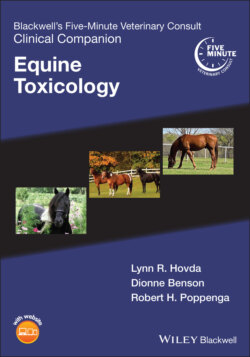Читать книгу Blackwell's Five-Minute Veterinary Consult Clinical Companion - Группа авторов - Страница 47
Chelating agents
ОглавлениеThese antidotes are generally used to remove heavy metals from the body. The chelating agent combines with a metal ion to form a complex that is then excreted.
Calcium disodium ethylenediaminetetraacetic acid or CaNa2EDTA (Calcium Disodium Versenate, Medicis):Labeled for use in pediatric and adult humans with acute and chronic lead poisoning. The use has declined over the years due to side‐effects and the decreased incidence of lead toxicosis in human beings.Still widely used in veterinary medicine to chelate lead, zinc, inorganic mercury, and perhaps cadmium, particularly in birds.Calcium disodium EDTA and not disodium EDTA must be used. These two should not be confused.Should not be used while lead remains in the GI tract as it may enhance the systemic absorption of lead.Use may result in GI signs.Nephrotoxic, so caution needs to be taken to ensure hydration; should not be used in animals with chronic renal failure.Dose: 73 mg/kg/day divided into two or three doses. Dilute product in 5% dextrose or 0.9% sodium chloride and give by slow IV over the course of the day. Administer for 3–5 days. Rest for 2 days. Repeat as needed.Alternate dose: 110 mg/kg IV BID × 2 days. Rest 2 days. Repeat as needed.IM injection is painful and not recommended.
Deferoxamine (Desferal, Novartis Pharmaceutical Corporation):Labeled in human beings for the treatment of acute iron intoxication and chronic iron overload due to transfusion‐dependent anemia. Veterinary experience is limited.Deferoxamine is most effective if used within the first 24 hours while iron is still in circulation and has not been distributed to tissues.Contraindicated in patients with severe renal disease or anuria and those with high circulating levels of aluminum.Complexes with iron; deferoxamine chelated complex is water‐soluble and excreted primarily in urine.A recommended dose of deferoxamine is 40 mg/kg IM every 4–8 h; can be given as a continuous infusion at the rate of 15 mg/kg/h. Chelation should continue until serum iron concentrations fall below 300 μg/dL (3 ppm) or below the TIBC.The excreted complex turns the urine pink or salmon‐colored and is sometimes referred to as the “vin rose” of iron poisoning. Continue treatment until the urine is clear or serum iron levels are within normal limits.
Dimercaprol (BAL in oil, Taylor):Labeled in human beings for use in the treatment of arsenic, gold, and mercury poisoning. Can also be used in acute lead poisoning concomitantly with CaNa2EDTA.Dimercaprol (British anti‐lewisite) is the classic arsenic chelator.Complex is water‐soluble and excreted in urine.A loading dose of 4–5 mg/kg is given by deep muscular injection, followed by 2–3 mg/kg q4h for 24 hours and then 1 mg/kg q4h for 2 days.IM injections are painful (peanut oil carrier) and should only be given deep IM.Adverse reactions include tremors, convulsions, and coma.Dimercaprol is nephrotoxic so limit use and monitor BUN and creatinine. Be sure that patients are adequately hydrated while product is used.
Dimercaptosuccinic acid (also referred to as DMSA or Succimer; Chemet, Schwartz):Labeled for use in pediatric human beings for lead poisoning when the blood levels are > 45 μg/mL. Unlabeled use includes mercury and arsenic toxicosis.Used in equines for arsenic toxicosis.DMSA is a less toxic chelator (equine dose not established, but 10 mg/kg PO q8h is suggested).Advantages over other chelators:Can be given PO or rectally if GI signs are severe.Incidence of adverse GI signs is much lower.Can be used while lead is still present in the GI tract.Disadvantages:Cost – expensive.Availability – often difficult to find.May have a transient increase in AST and ALT.
Digoxin immune Fab fragments – ovine (Digibind, Glaxo Smith Kline; Digifab, BTG Specialty Solutions):Specific antidote used for digoxin toxicosis. It may also be useful for cardiac glycoside containing plant intoxications.Fab fragments should be reserved for the treatment of life‐threatening cardiac arrhythmias that do not respond to conventional antiarrhythmic therapy.Expensive and will likely have to be obtained from a human hospital.Unknown equine dose; start with one or two vials and adjust up from there.
Pralidoxime hydrochloride (2‐PAM – Protopam Chloride, Wyeth):Pralidoxime is used in organophosphate (OP) toxicosis to reactivate cholinesterase enzymes inactivated by the insecticide. It binds to the enzyme attached to the OP and forms a pralidoxime–OP complex that detaches (reactivating the enzyme) and is excreted.Helps to prevent nicotinic signs and should be used in conjunction with atropine (see medications below).Limited benefits with carbamate toxicosis.Generally, pralidoxime should be used within 24 hours of exposure, but may still be effective when given at 36–48 h. These is some evidence that it is also effective when used for treatment of the intermediate syndrome of OP toxicosis.Dose: 20 mg/kg slow IV q 4–6 hours. May have to increase dose to 35 mg/kg.Rapid IV administration has resulted in tachycardia, neuromuscular blockade, laryngospasm, muscle rigidity and death.
